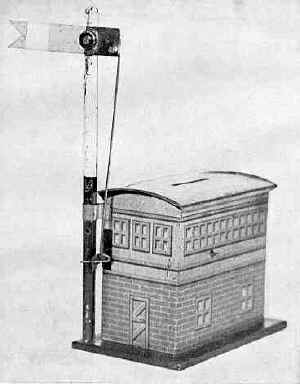Signal Cabin Bank
by F.H. Griffith - HOBBIES Magazine - June, 1969
 One of the fascinating aspects of collecting mechanical banks is
the complete lack of continuity or logic with respect to the timing or way in which some
of the scarce banks are found or turn up. A classic example of this situation is the
Signal Cabin, our choice as No. 175 in the numerical classification. Here we have a very
elusive small tin mechanical, quite fragile in its construction, and just non-existent in
the vast majority of bank collections. Year after year goes by and none turn up. Then what
happens — in the past year three Signal Cabins have come to light, the one pictured
being the most recent. This sure doesn’t make much sense, there’s no rhyme or
reason to it, but it certainly makes it interesting.
One of the fascinating aspects of collecting mechanical banks is
the complete lack of continuity or logic with respect to the timing or way in which some
of the scarce banks are found or turn up. A classic example of this situation is the
Signal Cabin, our choice as No. 175 in the numerical classification. Here we have a very
elusive small tin mechanical, quite fragile in its construction, and just non-existent in
the vast majority of bank collections. Year after year goes by and none turn up. Then what
happens — in the past year three Signal Cabins have come to light, the one pictured
being the most recent. This sure doesn’t make much sense, there’s no rhyme or
reason to it, but it certainly makes it interesting.
The Signal Cabin is one of the less spectacular of the action mechanicals but it does have a certain appeal. This is in connection with its being a tough item to add to a collection (a challenge to the collector) and the subject matter of the bank itself. Many people, collectors and otherwise, have an interest in trains and related items. Toy trains and accessories are widely collected by train buffs. Here in the Signal Cabin we have a sort of double identity, the train angle and the fact it is a mechanical bank. In other words, like the Pistol Bank (HOBBIES, December, 1961) which fits into two collection categories, toy pistols and mechanical banks, the Signal Cabin has the train-mechanical bank dual appeal.
The Signal Cabin shown is in fine all original condition with lithographed colors as follows: The base is black. The lower half of the building is red brick with yellow mortar. Two windows are on each side of the lower half and these are in brown framework with shaded window glass in white. The end of the building by the post has a wooden door representation in brown and the other end has a representation of a brown wooden ladder going to the second floor.
The upper half of the building is yellow woodwork with a long window running the entire length of each side. These large windows are the same colors as those in the lower section. Three windows also appear at the end of the building by the post and two windows and a brown wooden door are at the other end. This door is at the top of the aforementioned ladder. Over the door and just under the roof overhang is the wording "Made In Germany" in brown. The roof is a brighter red than the brickwork and has black shingle representation thereon. The lower half of the post is black and the upper white. The signal flag or semaphore is red, white and black, and the attachment holding the post to the building is red.
The action of the bank is simple but effective. A coin when dropped into the slot in the roof causes the semaphore to drop down, returning automatically to the position as shown in the picture. There is a balanced plate inside the building which is connected by a wire rod to the end of the semaphore. The weight of the coin causes the plate to dip down lowering the semaphore and the coin slides off this plate into the bottom of the building. On the underside of the base there is a very neatly made sliding coin trap for removal of coins.
While sometimes referred to as the Semaphore Bank, the name Signal Cabin has been more generally used for years and fits the bank quite well. As previously mentioned with respect to certain other mechanicals with similar operation, the weight of the coin itself causing the action and the necessity of using a coin to make the bank operate properly are very desirable features.
